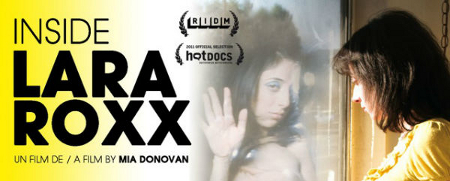CONQUERING A CRUEL FATE
CONQUERING A CRUEL FATE
An interview with Mia Donovan about her film INSIDE LARA ROXX
Kier-La Janisse
——————-
In 2004, Montreal-born Lara Roxx, a newcomer to LA’s adult film industry, was among three women who tested positive for HIV after performing unprotected sex discount cialis without prescription scenes with a more seasoned male actor, himself only recently diagnosed. Roxx had only been in the industry for a matter of months, and was quickly taken up by the press as an anti-pornography example to cialis cheap no prescription be exploited in the tabloids and on TV talk shows that scripted repenting monologues for her to recite. The film begins years after she has been forgotten by the press, with Lara now in a psychiatric ward in Montreal.
Filmmaker Mia Donovan follows Lara Roxx through several years of her life as she struggles to overcome depression and crack addiction, to reconnect generic propecia online within canada with her family and to re-examine the past that may have contributed toward her particular fate, which includes revisiting the LA porn industry circle to campaign for the de-stigmatization of condom use in sex films. The film is candid, sometimes uncomfortably personal, sad, uplifting, and most of all, a testament to the bravery of its subject and its filmmaker. And never does the film become a crusade in itself: while Donovan casts a critical eye on the adult film industry, she never judges or condemns it.
Certain battles have been won, but there are many more to come for an industry that straddles the lines of legality and subsists on a rotating crop of often viagra cheap fast shipping uninformed ingénues. Spectacular Optical talks to filmmaker and longtime Fantasia supporter Mia Donovan about her debut feature and the harsh realities of a high-risk profession.
——————-
Did you originally plan on becoming a filmmaker, or did your access to your subjects prompt you to pick up a camera?
A bit of both, I always wanted to become a filmmaker but it always seemed out of reach so instead I started out doing documentary photography. My last two photo series were both about women in the adult industry and it was while researching these projects that I learned about Lara Roxx. Originally I had approached Lara to take photos of her but after talking to her for several hours on the phone I decided I wanted to help her share her story. She had so much to say and was fueled by so much anger that she incited my desire to make the leap from photographer to filmmaker.
Can you talk about your place in the story? You’re off camera, but you’re also deliberately onscreen in reflections.
I approached the shooting of Inside Lara Roxx in a very naïve way, I say this in the sense that I did not have any formal training as a director or a cinematographer so I was shooting on instinct. I did not intentionally set out to be so ‘present’ in the film and it was only during the editing process with my editor Omar Majeed that we realized how intrinsic I was to the narrative. The decision to add some voiceover was a difficult choice to make as I wanted to avoid doing any voiceover but it was absolutely necessary in the end.
I thought it was very revealing when Lara stated her concern over the verity of your friendship – saying that she wouldn’t know until the film was completed whether you were really her friend. She seems to be trying to win your friendship by agreeing to be the subject of your film. Did you feel as though the film served a different purpose for each of you?
When Lara questioned whether or not I was sincerely her friend suggesting I may only be pretending to be her friend ‘to get the most out of her for the doc’, well, that was a sobering moment for me. It reminded me that I had a huge responsibility in my hands in terms of how I represented her. Of course, the documentary serves different purposes in both our lives. I think during the shooting process Lara was seeking attention and purpose in her own life above my initial motivation to help her spread HIV-awareness but that has evolved. Today Lara says the film is a form of therapy for her and recognizes the process of having so much of her troubled past documented as a reminder of where she doesn’t want to return. She says the film and the process of us shooting the film together helped her achieve a sort of closure for that part of her life. I am really proud of how far she has come since we stopped shooting and I have no doubt that we will always be in each others lives.
Why does Lara Roxx have so much affection for Bill Margold when he is the one who is most critical and least sympathetic to her situation?
Back in 2004, minutes after she was told that she tested positive for HIV, her friend brought her directly to Bill Margold’s office that was located across the street from Sharon Mitchell’s clinic. I think at that time, in 2004, he was a genuine comfort to her but the context was much different then when we revisited him in 2007. I think she feels ambivalence towards him now but still reserves a spot in her heart for him because of his generosity and support in 2004 while the rest of the industry was slamming its door in her face.
It was interesting that there was controversy surrounding Wiseman’s film Crazy Horse at RIDM (protesters denounced it as sensationalist and exploitive to women because it depicts the daily operations of a famous erotic cabaret in Paris), whereas your film is about a former porn star but was widely championed as heroic and life-affirming. I’m curious about where the boundary lies, as to when and why something becomes exploitation. I don’t know whether you’ve seen Crazy Horse or not, but what do you think is the danger zone where people start to think something is exploitation?
I haven’t seen Crazy Horse and am frankly quite confused over this alleged controversy. However, I had met some of these filmmakers that denounced Crazy Horse who compared the films by saying “Inside Lara Roxx get’s to know the woman behind the sensational headlines whereas Crazy Horse treats the women like objects without giving the audience the opportunity to get to know them.”
You say in the film that when you first saw Lara Roxx on TV, you initially thought of her as a victim, as someone who had been exploited. But many people think that ALL sex workers are being exploited, and that they’re delusional if they think they’re not. What are your thoughts on this?
First of all the term sex worker is such a broad term that covers so many different types of jobs each with their own degree of risk both physically and psychologically, and not to mention legally. But when I first saw Lara on the news I remember recognizing a naivety in her that I knew would not have made her well equipped to deal with the pressures of the porn industry. And when I finally met Lara she confirmed this initial impression that I had of her when she told me how she entered her agent’s office with an agenda to only shoot vaginal porn scenes with condoms and walked out of his office two hours later ready to shoot anal scenes without condoms. The danger is that these agents are experts at making even the most precarious situations sound glamorous, or at least safe and worth doing for the money. Any woman entering the business has to consider the risks involved and she has to understand how to say no and that it is okay to say no.
Inside Lara Roxx is a portrait about one woman and her sexual identity in the wake of testing positive for HIV. The porn industry in L.A has been relying on monthly PCR DNA blood tests for years now and this system has failed Lara Roxx and the other victims of this 2004 HIV outbreak, as well as a few more recent incidents. Lara resents it when people see her as a victim because in hindsight she wishes she’d been more aware of the risks she was putting herself in when she agreed to do the very high risk scene in which she was exposed to the virus. Unfortunately, back in 2004 Lara believed that the blood tests were 100% accurate. Her agents had convinced her that there was nothing to worry about in terms of HIV or other STDs because everyone had clean test results. This is the sad part of the story, the fact that many of these agents and producers sell the tests as protection and a lot of these young women who are 18, 19, 20-years-old want to believe that the tests are fine but the reality is that they are only a monitoring system.
Why did the few condom-only porn labels switch over (in the film it specifies that only one of the original condom-only companies had stuck it out with that mandate)? Is this buyer-dictated?
Back in 2004 when Lara tested positive there were actually two condom-only companies, Vivid and Wicked, in 2005 Vivid decided to go ‘condom-optional’ because of sales. So, yes, I assume this means there was consumer pressure. Consumers of porn need to realize that when they are watching a gang bang with like 6 guys and 1 girl that this is not a fiction film, it is more of a documentary then a fiction because the sex they see in porn is actually really taking place in real life and most of the time there is no condom. I find it interesting that the gay porn industry has been very successful with showing condoms as part of the sexual act and I don’t understand why heterosexual porn can’t make this leap successfully as well.
Is it possible to have a safe, respectful sex worker industry?
In terms of exploitation of sex workers, as I mentioned, sex worker is an extremely broad and misunderstood umbrella term that covers so many different types of jobs that have so many varied legal and safety issues that are specific to each job. For instance, I don’t consider a stripper in a non-contact strip club a sex worker. And, by the same token, I find it difficult to compare to an independent escort working in a city like Montreal to an 11-year-old brothel worker living in Bangladesh whose parents sold her to the brothel for a few hundred dollars.

 January 1, 2012
January 1, 2012  No Comments
No Comments





